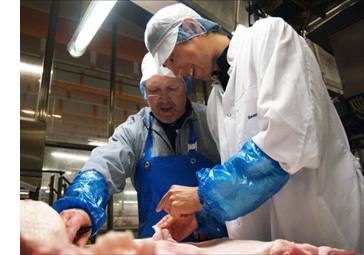- We get two visits each week. And that’s how it has been since 1983. Since the time of foot and mouth disease, we have had regular visits and checks performed by our Japanese inspectors, says Jørn Kjær from the Danish Crown slaughterhouse in Horsens. He has been the personal contact for all the inspectors.
- I think there have been about 80 inspectors over the years, says Jørn Kjær, before he goes out to greet Kazuya Shimojo – the current inspector – in the corridor.
Kazuya Shimojo is employed by Marudai Food Company as one of their inspectors. He is stationed in Vejle and every week makes visits to Danish Crown’s slaughterhouses in Horsens, Ringsted and Herning. Each visit to Horsens lasts six hours, during which time he takes random samples of streaky bacon, neck of pork and loin.
- I look out for all types of unwanted remnants from production in the form of bits of bone, gristle, hair as well as foreign bodies such as plastic. In addition, I check the length, width and thickness of the cuts in relation to our specifications, explains Kazuya Shimojo, as he makes his way down through the slaughterhouse’s main aisle.
At a table in the cutting section, several boxes are standing full of fresh cuts of streaky bacon which have just been taken off the conveyor belt. Above the table hangs a yellow sign with the word ‘REINSPECTION’ written in capital letters.

Japanese controller makes weekly visits to slaughterhouses in Horsens, Ringsted and Herning
Vagn Pedersen welcomes Mr Shimojo beside the table. Vagn Pedersen is a quality inspector, and focuses in particular on products destined for Japan. Together they start the day’s round.
- Our aim is to achieve a score of zero. However, it is incredibly difficult to prevent various remnants from coming into contact with the fresh cuts when they come straight off the belt.
Armed with a ruler, thermometer and very sensitive fingers, Kazuya Shimojo starts to carefully go over the selected cuts.
http://www.danishcrown.com/page22982.aspx



